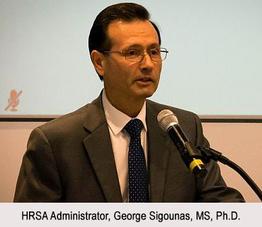
World AIDS Day
Telehealth and rural America

Noting that HRSA recently invested $203 million in health centers and rural communities to help fight the opioid epidemic, Dr. Sigounas said: "While the purpose of National Rural Health Day is to celebrate the efforts and contributions of rural America, it is difficult to think about rural health and not acknowledge the opioid crisis."
One response to the crisis, conferees said, is Project ECHO -- a new emphasis on telehealth as a means to deliver clinician training, patient consultation and case management to geographically isolated communities where hands-on care is scarce.
|
New HRSA behavioral health resource

HRSA's new gateway to behavioral health provides information on how HRSA programs are incorporating mental health and substance use treatment into service delivery and training.
Learn about behavioral health initiatives involving HRSA-funded safety net providers and training/education grant programs. You'll also find a wide range of technical assistance resources on integrating behavioral health and primary care.
Use the Behavioral Health Treatment Services Locator to find the nearest behavioral health organization or HRSA grantee that provides behavioral health services in your community.
|
New dementia learning modules for caregivers

Find out more about HRSA’s new learning modules to help family and other caregivers of people living with dementia address the challenges of caregiving.
The modules are a supplemental resource to HRSA’s Alzheimer’s Disease and Related Dementia’s Training Curriculum that trains the primary care workforce about dementia care and helps providers address caregiver needs.
Intended for health professions faculty and students, primary care practitioners, and direct service providers, the curriculum and supplemental modules promote inter-professional teamwork in the care of persons living with dementia.
|
FDA issues recommendations on covers for hospital bed mattresses

Over time, hospital bed mattress covers can wear out and allow blood and body fluids to penetrate and get trapped inside mattresses. If blood or body fluids from one patient penetrate and get absorbed in a mattress, the fluids can leak out the next time the mattress is used. Coming into contact with these fluids poses a risk of infection to patients using the bed.
The FDA issued a safety communication in 2013 alerting health care providers, health care facility staff, and caregivers to these safety concerns. From 2011 through 2016, the FDA has received over 700 reports of a hospital bed mattress cover failing to prevent blood or body fluids from leaking into the mattress.
|
National health promotion and disease prevention objectives: Healthy People
Secretary's Advisory Committee for 2030December 11, 3 - 5 p.m. ET
Be a part of the Healthy People 2030 development process. Register today for the 7th meeting of the Secretary’s Advisory Committee on National Health Promotion and Disease Prevention Objectives for 2030 (Committee). The Committee will:
- Discuss potential revisions to the proposed Healthy People 2030 framework based on public comments
- Further develop subcommittee recommendations on topics including stakeholder engagement, health literacy, health and well-being, and law and policy
Healthy People 2020 Progress Review Webinar
December 12, 12:30 - 2 p.m. ET
Register for a Healthy People 2020 Progress Review webinar featuring early and middle childhood & adolescent health. The Progress Review webinars focus on tracking and measuring the progress of select Healthy People 2020 objectives throughout the decade.
You'll also learn how the City of Cincinnati Health Department is taking a comprehensive approach to providing school-based health services.






















.png)









No hay comentarios:
Publicar un comentario